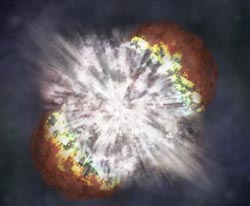Three of the most luminous supernovae on record — 2006gy, 2005gj, and 2005ap — pose problems for theorists. For example, 2006gy’s peak luminosity reached 50 billion Suns. That’s 10 times brighter than the average type Ia supernova and 100 times brighter than a representative type II. And 2005ap was 2 times brighter still.
 What’s a theorist to do? In our January issue, I noted that astronomers suspected some of these events might be so-called “pair-production” supernovae. This mechanism was hypothesized 40 years ago, but no one’s ever seen a supernova that matches it. In essence, a star’s core gets so hot that colliding gamma rays spontaneously create pairs of particles — an electron and a positron. The particle creation removes pressure. The star begins to collapse, but then detonates in runaway thermonuclear reactions.
What’s a theorist to do? In our January issue, I noted that astronomers suspected some of these events might be so-called “pair-production” supernovae. This mechanism was hypothesized 40 years ago, but no one’s ever seen a supernova that matches it. In essence, a star’s core gets so hot that colliding gamma rays spontaneously create pairs of particles — an electron and a positron. The particle creation removes pressure. The star begins to collapse, but then detonates in runaway thermonuclear reactions.
This scenario works better for some of the superbright supernovae than others. So what else do theorists have up their sleeves?
At the American Astronomical Society meeting in St. Louis today, Denis Leahy and Rachid Ouyed at the University of Calgary suggested something radical. They say the explosive conversion of a neutron star into a quark star has the right properties to account for all three of these quirky supernovae.
Neutron stars, the crushed, superdense cores of massive stars, form in some supernovae. They pack a mass of 1.5 Suns into a ball just 16 miles wide. Quark stars, if they exist, have similar masses, but are crunched down even smaller, to 12 miles across. Leahy and Ouyed suggest that, when a neutron star’s density gets too high, its neutrons dissolve into their component quarks — and release a burst of energy similar to the original supernova.
Here’s how they think it might have worked. Because the superbright supernovae all occurred far away, astronomers wouldn’t detect the initial neutron-star-forming explosion. The supernova remnant’s hot plasma expands to about 100 times the Earth-Sun distance.
By then, the unstable neutron star shudders into its new, more compressed configuration: a quark star. The shock wave from this second explosion drives into and heats the existing remnant. The large size of the remnant at the time of the second explosion is the key to making superluminous supernovae, the scientists say.
Heh. Quark stars. I love astrophysics.